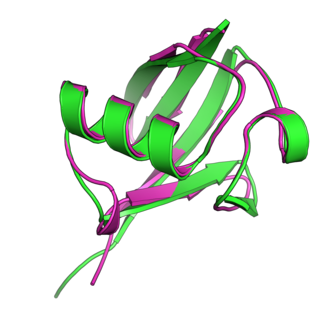
Ubiquitin is a small regulatory protein found in most tissues of eukaryotic organisms, i.e., it is found ubiquitously. It was discovered in 1975 by Gideon Goldstein and further characterized throughout the late 1970s and 1980s. Four genes in the human genome code for ubiquitin: UBB, UBC, UBA52 and RPS27A.

Autophagy is the natural, conserved degradation lysosome dependent regulated mechanism of the cell that removes unnecessary or dysfunctional components. It allows the orderly degradation and recycling of cellular components. Although initially characterized as a primordial degradation pathway induced to protect against starvation, it has become increasingly clear that autophagy also plays a major role in the homeostasis of non-starved cells. Defects in autophagy have been linked to various human diseases, including neurodegeneration and cancer, and interest in modulating autophagy as a potential treatment for these diseases has grown rapidly.

Pichia pastoris is a species of methylotrophic yeast. It was found in the 1960s, with its feature of using methanol, as a source of carbon and energy. After years of study, P. pastoris was widely used in Biochemical research and Biotech industries. With strong potential for being an expression system for protein production, as well as being a model organism for genetic study, P. pastoris has become important for biological research and biotech applications. In the last decade, some reports reassigned P. pastoris to the genus Komagataella with phylogenetic analysis, by genome sequencing of P. pastoris. The species was split into K. phaffii, K. pastoris, and K. pseudopastoris.
Autophagin-1 (Atg4/Apg4) is a unique cysteine protease responsible for the cleavage of the carboxyl terminus of Atg8/Apg8/Aut7, a reaction essential for its lipidation during autophagy. Human Atg4 homologues cleave the carboxyl termini of the three human Atg8 homologues, microtubule-associated protein light chain 3 (LC3), GABARAP, and GATE-16.

Gamma-aminobutyric acid receptor-associated protein is a protein that in humans is encoded by the GABARAP gene.

Autophagy related 5 (ATG5) is a protein that, in humans, is encoded by the ATG5 gene located on Chromosome 6. It is an E3 ubi autophagic cell death. ATG5 is a key protein involved in the extension of the phagophoric membrane in autophagic vesicles. It is activated by ATG7 and forms a complex with ATG12 and ATG16L1. This complex is necessary for LC3-I conjugation to PE (phosphatidylethanolamine) to form LC3-II. ATG5 can also act as a pro-apoptotic molecule targeted to the mitochondria. Under low levels of DNA damage, ATG5 can translocate to the nucleus and interact with survivin.

Microtubule-associated proteins 1A/1B light chain 3B is a protein that in humans is encoded by the MAP1LC3B gene. LC3 is a central protein in the autophagy pathway where it functions in autophagy substrate selection and autophagosome biogenesis. LC3 is the most widely used marker of autophagosomes.

Cysteine protease ATG4B is an enzyme that in humans is encoded by the ATG4B gene.

Gamma-aminobutyric acid receptor-associated protein-like 2 is a protein that in humans is encoded by the GABARAPL2 gene.

Sentrin-specific protease 6 is an enzyme that in humans is encoded by the SENP6 gene.

Autophagy-related protein 10 is a protein that in humans is encoded by the ATG10 gene.

Autophagy related 16 like 1 is a protein that in humans is encoded by the ATG16L1 gene. This protein is characterized as a subunit of the autophagy-related ATG12-ATG5/ATG16 complex and is essentially important for the LC3 (ATG8) lipidation and autophagosome formation. This complex localizes to membrane and is released just before or after autophagosome completion.

Autophagy related 12 is a protein that in humans is encoded by the ATG12 gene.

Ubiquitin-fold modifier 1, also known as UFM1, is a protein which in humans is encoded by the UFM1 gene.

Cysteine protease ATG4A is an enzyme that in humans is encoded by the ATG4A gene.

Autophagy-related protein 8 (Atg8) is a ubiquitin-like protein required for the formation of autophagosomal membranes. The transient conjugation of Atg8 to the autophagosomal membrane through a ubiquitin-like conjugation system is essential for autophagy in eukaryotes. Even though there are homologues in animals, this article mainly focuses on its role in lower eukaryotes such as Saccharomyces cerevisiae.
In molecular biology, autophagy related 3 (Atg3) is the E2 enzyme for the LC3 lipidation process. It is essential for autophagy. The super protein complex, the Atg16L complex, consists of multiple Atg12-Atg5 conjugates. Atg16L has an E3-like role in the LC3 lipidation reaction. The activated intermediate, LC3-Atg3 (E2), is recruited to the site where the lipidation takes place.

Yoshinori Ohsumi is a Japanese cell biologist specializing in autophagy, the process that cells use to destroy and recycle cellular components. Ohsumi is a professor at Tokyo Institute of Technology's Institute of Innovative Research. He received the Kyoto Prize for Basic Sciences in 2012, the 2016 Nobel Prize in Physiology or Medicine, and the 2017 Breakthrough Prize in Life Sciences for his discoveries of mechanisms for autophagy.

Ubiquitin-like proteins (UBLs) are a family of small proteins involved in post-translational modification of other proteins in a cell, usually with a regulatory function. The UBL protein family derives its name from the first member of the class to be discovered, ubiquitin (Ub), best known for its role in regulating protein degradation through covalent modification of other proteins. Following the discovery of ubiquitin, many additional evolutionarily related members of the group were described, involving parallel regulatory processes and similar chemistry. UBLs are involved in a widely varying array of cellular functions including autophagy, protein trafficking, inflammation and immune responses, transcription, DNA repair, RNA splicing, and cellular differentiation.

Ubiquitin-fold modifier conjugating enzyme 1 is a protein that in humans is encoded by the UFC1 gene.




















